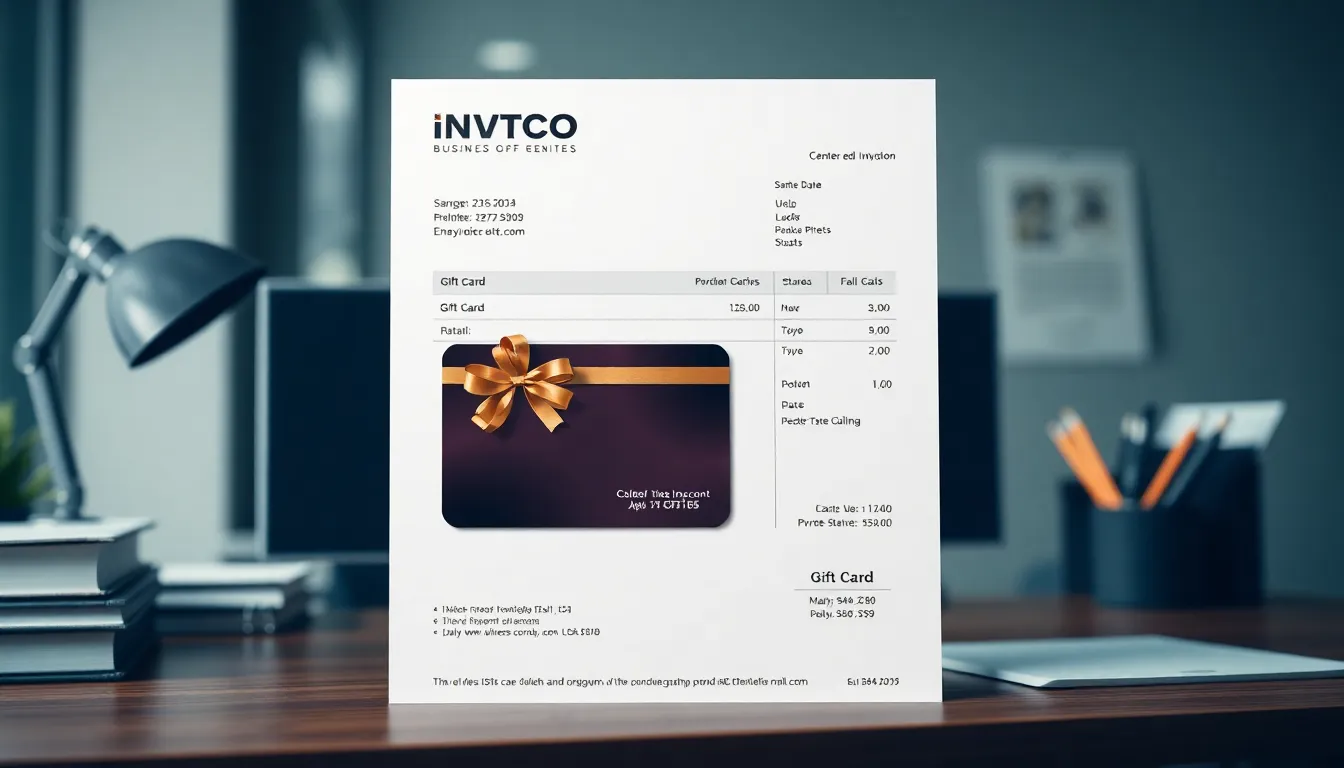Managing client billing can get tricky when you’re dealing with gift card purchases or redemptions. We’ve all been there – wondering how to properly structure invoices when gift cards enter the equation. Whether you’re a business owner selling gift cards or accepting them as payment, getting the billing format right is crucial for accurate financial records and customer satisfaction.
The challenge isn’t just about creating the invoice. You’ll need to consider tax implications, accounting practices, and legal requirements that vary depending on your location and business type. Gift card transactions often involve deferred revenue recognition, which means your billing approach must align with proper accounting standards.
We’ll walk you through the essential steps to create professional, compliant invoices for gift card transactions. From setting up the right format to handling various scenarios like partial redemptions and refunds, you’ll discover practical strategies that streamline your billing process and keep your books organized.
Understanding Gift Card Billing Fundamentals
We’ll establish the core principles that govern proper gift card billing practices to ensure accurate financial records and regulatory compliance.
Defining Gift Card Transaction Types
Purchase transactions represent the initial sale when clients buy gift cards from your business. These create a liability on your balance sheet since you’ve received payment but haven’t yet delivered goods or services. Redemption transactions occur when customers use their gift cards to make purchases, converting the liability into earned revenue.
Partial redemption scenarios happen when clients use only a portion of their gift card value. We must track remaining balances and update our records accordingly. Reload transactions involve adding additional funds to existing gift cards, increasing the liability amount.
Refund situations require reversing previous transactions and may involve cash payments or credit adjustments. Each transaction type demands exact documentation and accounting treatments to maintain accurate billing records.
Identifying Tax Implications for Gift Card Sales
Sales tax collection varies significantly based on your business location and local regulations. Most jurisdictions don’t require collecting sales tax at the time of gift card purchase since no taxable transaction has occurred yet. Tax liability transfers to the redemption point when customers actually receive goods or services.
Multi-state operations complicate tax calculations when gift cards are sold in one location but redeemed in another. We need systems that track where sales occur and apply appropriate tax rates during redemption. Digital gift cards may have different tax implications than physical cards depending on local laws.
Business-to-business gift card sales often involve different tax treatment than consumer transactions. Professional services and corporate clients may have exact tax exemptions or requirements that affect how we structure our invoices.
Recognizing Revenue Recognition Requirements
Deferred revenue accounting requires treating gift card sales as liabilities rather than immediate income. We record the initial sale as “unearned revenue” or “customer deposits” on our balance sheet until redemption occurs. Revenue recognition happens when clients redeem gift cards for actual products or services.
Breakage revenue policies address situations where gift cards expire or go unused. Many businesses can recognize a portion of unredeemed gift card value as revenue after exact time periods, but this varies by jurisdiction and requires careful documentation.
Partial service delivery scenarios need precise tracking when clients redeem gift cards for services delivered over multiple billing periods. We must allocate revenue appropriately across the service timeline to maintain accurate financial reporting and client billing transparency.
Setting Up Your Gift Card Billing System

Building an effective gift card billing system requires careful selection of tools and processes that integrate seamlessly with your existing financial operations. We’ll walk you through the essential components that ensure accurate tracking and compliant billing practices.
Choosing the Right Accounting Software
QuickBooks Online stands out as our top recommendation for businesses handling gift card transactions, offering built-in liability tracking and automated revenue recognition features. The software automatically creates deferred revenue entries when you record gift card sales and converts them to income upon redemption.
Xero provides excellent multi currency support for businesses operating internationally, making gift card billing management simpler across different regions. Their reporting dashboard displays real time gift card liability balances and breakage analysis.
FreshBooks excels for service based businesses that offer gift certificates, featuring customizable invoice templates specifically designed for gift card purchases. The platform integrates directly with popular POS systems to sync gift card transactions automatically.
Wave Accounting offers a free solution for small businesses starting their gift card programs, though it requires manual entry for most gift card transactions. Even though the manual process, it provides adequate reporting for basic gift card billing needs.
Creating Gift Card Product Categories
Digital gift cards require separate SKU codes from physical cards to distinguish delivery methods and associated costs in your billing system. We recommend using product codes like “GC-DIGITAL-[VALUE]” to identify electronic gift card sales instantly.
Physical gift cards need inventory tracking capabilities since they represent tangible products with production and shipping costs. Create categories that include card design variations, denominations, and packaging options for accurate billing.
Promotional gift cards should be tracked separately from paid gift cards to maintain clear revenue recognition and expense allocation. These categories help distinguish between marketing expenses and actual gift card sales revenue.
Corporate gift card programs require specialized billing categories that accommodate bulk purchases, volume discounts, and extended payment terms. Set up separate product categories for B2B transactions to simplify invoicing and reporting processes.
Establishing Gift Card Tracking Methods
Sequential numbering systems provide the most reliable method for tracking individual gift card transactions and preventing fraud or duplicate billing. We assign unique identifiers that connect each card to its purchase transaction, redemption history, and current balance.
Batch tracking methods work effectively for businesses processing large volumes of gift card sales, allowing you to group cards by date, promotion, or sales channel. This approach simplifies reconciliation and reporting while maintaining adequate transaction visibility.
Real time balance monitoring ensures accurate billing by updating gift card values immediately after each transaction occurs. Integration with your POS system prevents overselling and maintains current liability records for financial reporting.
Expiration date management requires automated tracking systems that monitor card aging and trigger breakage revenue recognition according to your established policies. We recommend setting up monthly reports that identify cards approaching expiration dates for proper accounting treatment.
Creating Professional Gift Card Invoices

We’ll establish the foundation for clear billing processes by focusing on detailed invoice documentation. Professional invoicing ensures compliance with accounting standards and builds client trust through transparent communication.
Including Essential Invoice Elements
Invoice headers must contain your business name, logo, and complete contact information. We recommend placing this information prominently at the top of every gift card invoice to establish credibility and provide easy reference for clients.
Sequential invoice numbers help track transactions and prevent duplicate billing. Our system generates unique identifiers that include the invoice date and transaction type, such as “GC-2024-001” for gift card purchases or “GCR-2024-001” for redemptions.
Client details require accurate billing addresses and contact information. We verify this data before processing to avoid payment delays and ensure proper tax jurisdiction calculations. Include the client’s tax identification number for business to business transactions.
Transaction dates must reflect both the invoice date and service delivery date. We separate these dates to maintain accurate revenue recognition records, especially important for gift card purchases where delivery may occur days after the initial order.
Line item descriptions need exact details about each gift card transaction. Our invoices clearly state whether charges relate to gift card purchases, redemption processing fees, or administrative costs to eliminate confusion during client review.
Adding Gift Card Exact Details
Gift card denominations require individual line items with exact dollar amounts. We list each card value separately to provide transparency and enable proper tracking of inventory levels and revenue recognition obligations.
Card identification numbers enhance security and help customer service. Our invoices include partial card numbers (showing only the last four digits) to help clients identify exact cards without compromising security protocols.
Expiration dates inform clients about redemption deadlines and legal requirements. We display these dates prominently since many states have exact regulations governing gift card validity periods and breakage revenue recognition.
Purchase versus redemption classifications prevent accounting errors. We use distinct invoice codes and descriptions to differentiate between new card sales and redemption transactions, ensuring accurate financial reporting.
Batch numbers connect related transactions for wholesale or corporate clients. Our system groups bulk purchases under single batch identifiers while maintaining individual card tracking capabilities for inventory management.
Formatting Payment Terms and Conditions
Payment due dates establish clear expectations for invoice settlement. We typically set 15 day payment terms for gift card purchases since clients often need immediate card delivery for promotional campaigns or events.
Accepted payment methods should accommodate client preferences and business needs. Our invoices specify options such as ACH transfers, credit cards, or wire transfers, including any processing fees associated with each payment type.
Late payment penalties protect cash flow and encourage timely settlement. We charge 1.5% monthly interest on overdue balances after a 10 day grace period, clearly stating these terms to avoid disputes.
Refund policies outline procedures for gift card returns or cancellations. Our terms specify that unused cards may be refunded within 30 days of purchase, minus any processing fees, while redeemed cards cannot be refunded.
Tax information clarifies responsibility and calculation methods. We itemize applicable sales taxes and clearly indicate whether taxes apply at purchase or redemption based on local jurisdiction requirements and the exact nature of each transaction.
Implementing Proper Gift Card Revenue Recognition

Proper revenue recognition ensures we maintain compliance with accounting standards while accurately reflecting our business’s financial position. Gift card transactions require careful attention to timing and documentation to meet both GAAP requirements and client expectations.
Recording Initial Gift Card Sales
Record gift card sales as deferred revenue immediately upon purchase to establish proper liability tracking. We must classify these transactions as current liabilities rather than immediate revenue since we haven’t yet delivered goods or services to customers.
Create separate liability accounts for different gift card types to maintain clear financial records. Digital gift cards should have their own account distinct from physical cards and promotional offerings. This separation helps us track redemption patterns and identify which products generate the most customer engagement.
Document each transaction with comprehensive details including card numbers and purchase amounts. Our accounting entries should include the cash received as a debit and unearned revenue as a credit. We recommend using account codes like 2300 for gift card liabilities to ensure consistent classification across all transactions.
Generate purchase confirmation receipts that clearly state the card’s terms and conditions. These receipts serve as legal documentation and help prevent disputes about expiration dates or usage restrictions. We should include activation instructions and customer service contact information to enhance the client experience.
Tracking Gift Card Redemptions
Monitor gift card redemptions in real time to maintain accurate balance records and recognize revenue appropriately. Each redemption triggers a reduction in our liability account and creates recognizable revenue equal to the redeemed amount.
Establish automatic posting procedures that transfer amounts from deferred revenue to earned revenue accounts. We use transaction matching systems that verify card numbers against our database and update balances instantly. This automation prevents human errors and ensures we capture all redemption activity accurately.
Create detailed redemption reports that show transaction dates and remaining card balances. Our reporting system should track partial redemptions and flag unusual activity patterns that might indicate fraud or system errors. We recommend generating daily reconciliation reports to catch discrepancies before they compound.
Carry out security protocols that verify card authenticity during redemption transactions. Multi factor authentication and PIN verification systems protect both our business and clients from unauthorized usage. We maintain audit trails that document who processed each redemption and when the transaction occurred.
Managing Unredeemed Gift Card Balances
Establish clear breakage policies for unredeemed gift cards to comply with state regulations and optimize revenue recognition. Breakage revenue represents the portion of gift card sales we don’t expect customers to redeem based on historical data and statutory requirements.
Calculate breakage rates using at least three years of redemption data to establish reliable patterns. We analyze redemption trends by card denomination and purchase channel to refine our estimates. Most businesses experience breakage rates between 6% and 19% depending on their industry and customer demographics.
Review unredeemed balances quarterly to identify cards approaching expiration dates. State regulations vary significantly about gift card expiration and escheatment requirements. We must comply with laws in states where our customers reside rather than just where our business operates.
Transfer aged gift card balances to appropriate escheatment accounts when required by state law. Unclaimed property laws typically require businesses to report and remit unredeemed gift card balances after exact time periods. We maintain detailed records showing card purchase dates and customer contact information to support these compliance requirements.
Handling Gift Card Tax Considerations

Tax compliance becomes critical when billing clients for gift card purchases and redemptions. We’ll explore the essential tax requirements and regulatory considerations that impact your gift card billing process.
Understanding Sales Tax Requirements
Sales tax collection timing differs significantly between gift card purchases and redemptions. Most states don’t require collecting sales tax when clients initially purchase gift cards because no actual goods or services transfer at that point. The liability for sales tax typically arises when customers redeem their cards for taxable products or services.
Redemption transactions trigger sales tax obligations based on the exact items purchased. When customers use gift cards to buy taxable merchandise, we must calculate and collect appropriate sales tax rates for those particular products. This means maintaining detailed records of what customers purchase with their gift cards rather than applying blanket tax rates.
Multi location businesses face complex tax calculation challenges. If your clients operate across multiple jurisdictions, each redemption location may have different tax rates and exemptions. We recommend implementing point of sale systems that automatically calculate local tax rates based on the redemption location rather than the original purchase location.
B2B gift card transactions often qualify for tax exemptions. Corporate clients purchasing gift cards for employee rewards or customer incentives may provide valid resale certificates or exemption documents. We must verify these certificates and maintain proper documentation to support tax exempt status during audits.
Managing State Exact Gift Card Regulations
Escheatment laws vary dramatically across different states about unredeemed gift card balances. Some states like California require turning over unused gift card funds to the state after exact dormancy periods, while others have no escheatment requirements. We need to track the purchase location and applicable state laws for each gift card to ensure compliance.
Expiration date regulations differ significantly between jurisdictions. Federal law prohibits gift card expiration within five years of purchase, but individual states may impose stricter requirements. States like Connecticut and California have additional consumer protection laws that we must consider when structuring gift card terms and billing arrangements.
Fee structures require careful attention to state regulations. While federal law limits inactivity fees on gift cards, some states prohibit all fees entirely. We must review state exact requirements before implementing any maintenance or dormancy fees in our client billing structures.
Gift card disclosure requirements affect invoice documentation. Many states mandate exact language about terms, conditions, and consumer rights that must appear on gift cards and related documentation. Our billing invoices should reference these disclosures to maintain regulatory compliance.
Documenting Tax Exempt Gift Card Transactions
Valid exemption certificates must accompany all tax exempt gift card purchases. We require clients claiming tax exempt status to provide current resale certificates, nonprofit exemption letters, or government purchase orders before processing their orders. These documents should include expiration dates and applicable tax identification numbers.
Proper record keeping becomes essential for supporting tax exempt transactions. Our invoice documentation must clearly indicate the exemption type, certificate number, and legal basis for the tax free treatment. This information proves crucial during state tax audits or compliance reviews.
Verification procedures help prevent fraudulent exemption claims. We recommend implementing automated systems that cross reference exemption certificates with state databases when available. This validation process reduces audit risks and ensures we’re only granting legitimate tax exempt status.
Exemption limitations require ongoing monitoring and documentation. Some tax exempt organizations have restrictions on their exemptions that may not apply to gift card purchases intended for fundraising or resale activities. We must maintain detailed records showing how exempt organizations plan to use their gift cards to support the tax free treatment.
Managing Gift Card Billing Documentation

Proper documentation management ensures accurate financial reporting and regulatory compliance throughout the gift card lifecycle. We’ll examine the essential record-keeping practices that protect your business and streamline audit processes.
Maintaining Gift Card Purchase Records
Purchase records form the foundation of your gift card billing documentation system. We recommend creating individual transaction files that include the original purchase invoice, payment confirmation, card activation details, and customer information for each gift card sold.
Digital storage systems like Google Drive or Dropbox provide secure access to purchase records while maintaining backup copies. Your documentation should capture the purchase date, card denomination, unique identification number, payment method, and purchaser details to establish a complete audit trail.
Sequential filing systems work best for organizing gift card purchases by date or transaction number. We suggest creating monthly folders that contain all purchase documentation, making it easier to locate exact transactions during reconciliation periods or compliance audits.
Key Purchase Documentation Elements:
| Document Type | Required Information | Retention Period |
|---|---|---|
| Purchase Invoice | Card ID, amount, date, customer | 7 years |
| Payment Receipt | Transaction ID, method, confirmation | 7 years |
| Activation Record | Card status, activation timestamp | 3 years |
| Customer Data | Name, contact, purchase history | Per privacy law |
Creating Redemption Tracking Systems
Redemption tracking systems monitor gift card usage patterns and maintain accurate balance records. We carry out automated logging that captures each redemption transaction with timestamps, remaining balances, merchant locations, and transaction amounts to ensure comprehensive oversight.
Real-time tracking prevents double spending and provides immediate balance updates across all sales channels. Your system should generate redemption confirmations that include the transaction reference number, date of use, amount redeemed, and remaining card balance for customer records.
Database integration connects redemption records with your accounting software to automatically update revenue recognition entries. We recommend establishing daily reconciliation procedures that compare system balances with actual redemption activity to identify discrepancies quickly.
Partial redemption scenarios require detailed tracking to maintain accuracy across multiple transactions. Your documentation should record each partial use with sequential transaction numbers, enabling customers and staff to review complete usage history when needed.
Storing Compliance Documentation
Compliance documentation storage protects your business from regulatory penalties and audit challenges. We maintain separate folders for tax certificates, state registration documents, breakage policy documentation, and unclaimed property filings to ensure quick access during compliance reviews.
Cloud-based storage answers offer automatic backup features and access controls that limit document viewing to authorized personnel only. Your compliance files should include state-exact gift card regulations, sales tax exemption certificates, and annual reporting submissions with clear organization by jurisdiction.
Version control systems track changes to compliance documents over time, maintaining historical records of policy updates and regulatory modifications. We suggest implementing quarterly reviews of stored documentation to verify completeness and update expired certificates or registrations.
Essential Compliance Documents:
- State gift card registration certificates
- Sales tax permit documentation
- Breakage policy statements and approvals
- Unclaimed property filing confirmations
- Privacy policy compliance records
- Security audit reports and certifications
Retention schedules align with state and federal requirements, typically ranging from three to seven years depending on document type. Your storage system should include automated alerts for document expiration dates and renewal requirements to maintain continuous compliance status.
Automating Gift Card Billing Processes

Streamlining gift card billing through automation reduces manual errors and saves valuable time for growing businesses. We’ll explore essential automation tools that transform complex gift card management into efficient, accurate processes.
Setting Up Automated Invoice Generation
Configure your accounting software to automatically generate invoices when gift card transactions occur. Most platforms like QuickBooks Online and Xero offer workflow automation that triggers invoice creation based on exact transaction types. Set up rules that distinguish between gift card purchases, reloads, and corporate bulk orders to ensure proper categorization.
Establish template customization for different gift card billing scenarios. Create separate invoice templates for individual purchases, business-to-business transactions, and promotional gift card distributions. These templates should include pre-populated fields for gift card denominations, card identification numbers, and applicable tax calculations based on your business location.
Schedule recurring invoices for subscription-based gift card programs. Many businesses offer monthly gift card deliveries or corporate employee reward programs that require consistent billing cycles. Configure your system to automatically generate these invoices on predetermined dates while adjusting for holidays and business closure periods.
Set up automatic payment processing integration with popular payment gateways. Connect your invoice generation system to processors like Stripe, PayPal, or Square to enable seamless payment collection. This integration ensures that gift card activation occurs immediately upon successful payment confirmation.
Implementing Real-Time Balance Updates
Connect your point-of-sale system directly to your accounting software for instant balance tracking. This integration eliminates the delay between gift card redemptions and balance adjustments that often causes discrepancies in financial reports. Popular POS systems like Shopify, Clover, and Toast offer APIs that sync transaction data within seconds.
Create automated liability adjustments when gift cards are redeemed or partially used. Configure your system to automatically move funds from deferred revenue accounts to actual revenue accounts based on redemption activities. This process ensures compliance with accounting standards while maintaining accurate financial statements.
Establish real-time notification systems for low balance alerts and redemption activities. Set up email or SMS notifications that alert your team when gift card balances drop below certain thresholds or when high-value redemptions occur. These alerts help prevent fraud and maintain inventory control for physical gift card programs.
Carry out automatic breakage recognition based on predetermined timeframes and state regulations. Configure your system to identify unredeemed gift cards that meet breakage criteria according to your business policies and local unclaimed property laws. This automation ensures timely revenue recognition while maintaining compliance with varying state requirements.
Creating Automated Reporting Systems
Generate daily reconciliation reports that compare gift card sales, redemptions, and outstanding balances. These automated reports should highlight any discrepancies between your POS data and accounting records, enabling quick identification and resolution of errors. Schedule these reports to run after business hours and deliver them to your accounting team each morning.
Set up monthly breakage analysis reports to track unredeemed gift card patterns. Configure your system to analyze gift card usage data and identify trends in redemption timeframes, popular denominations, and seasonal variations. These insights help optimize your gift card program and improve revenue forecasting accuracy.
Create automated tax reporting that categorizes gift card transactions by jurisdiction and tax obligation. This system should separate taxable redemptions from non-taxable sales while tracking location-exact tax rates for multi-state operations. Generate quarterly reports that summarize tax liabilities and provide supporting documentation for regulatory filings.
Establish customer communication automation for gift card expiration warnings and balance notifications. Configure your system to send automatic emails to gift card holders 30, 60, and 90 days before expiration dates where legally required. Include current balance information and redemption instructions to maximize customer satisfaction and reduce escheatment obligations.
Troubleshooting Common Gift Card Billing Issues

Gift card billing complications can disrupt your revenue flow and strain client relationships. We’ll address the most frequent issues and provide actionable answers to maintain smooth operations.
Resolving Payment Processing Problems
Payment processing failures often stem from network connectivity issues or outdated POS systems. Check your internet connection and ensure all payment terminals are properly connected to your processing network. Network outages typically cause transaction timeouts and error messages that prevent gift card purchases from completing.
System integration problems frequently occur when your POS doesn’t communicate effectively with your gift card platform. Update your payment processing software to the latest version and verify that your gift card provider’s API is properly configured. Integration mismatches can cause duplicate charges or failed transaction records that complicate billing reconciliation.
Credit card declines during gift card purchases require immediate attention to avoid lost sales. Verify that your merchant account accepts the payment method and check for daily processing limits that might block transactions. Payment processors sometimes flag large gift card purchases as suspicious activity requiring manual approval.
Batch processing errors can delay gift card activation and frustrate customers waiting to use their cards. Run daily settlement reports to identify failed transactions and contact your payment processor to resolve pending authorizations. Settlement delays often indicate communication problems between your POS system and the processing bank.
Handling Disputed Gift Card Transactions
Documentation requirements become critical when clients dispute gift card charges or redemptions. Maintain detailed transaction logs including timestamps, card numbers, purchase amounts, and customer identification to support your position. Digital receipts and security camera footage provide additional evidence during dispute resolution processes.
Chargeback claims require prompt response within the specified timeframe to avoid automatic liability. Submit compelling evidence including signed receipts, activation records, and usage history to demonstrate legitimate transactions. Chargeback ratios above industry standards can increase your processing fees and trigger additional compliance requirements.
Fraud prevention measures help reduce disputed transactions and protect your business reputation. Carry out card verification systems that require customer identification for high-value purchases and unusual transaction patterns. Fraudulent activity often involves multiple small purchases or immediate high-value redemptions that warrant additional scrutiny.
Customer communication protocols ensure transparent dispute resolution and maintain positive relationships. Contact disputing customers directly to understand their concerns and provide transaction details that clarify billing charges. Clear communication often resolves disputes without formal chargeback proceedings that cost time and money.
Managing Expired Gift Card Balances
State regulations determine how you must handle unredeemed gift card balances after expiration dates pass. Research your jurisdiction’s escheatment laws to understand reporting requirements and transfer obligations for unclaimed property. Some states prohibit expiration dates entirely while others require exact notice periods before balance forfeiture.
Breakage revenue recognition allows you to claim expired balances as income according to accounting standards. Calculate expected breakage rates based on historical redemption patterns and recognize revenue proportionally over the estimated usage period. Conservative breakage estimates protect against overstatement of revenue and potential regulatory scrutiny.
Customer notification systems help maintain compliance and reduce disputes over expired balances. Send automated emails or text messages at 90, 60, and 30 days before expiration to encourage redemption. Proper notice documentation protects your business if customers claim they weren’t informed about approaching expiration dates.
Grace period policies can improve customer satisfaction while maintaining legal compliance. Consider extending expired cards for 30 to 90 days as a goodwill gesture that may encourage additional purchases. Balance transfer options to new cards preserve customer value and demonstrate commitment to fair treatment practices.
Best Practices for Gift Card Client Communication

Effective client communication forms the foundation of successful gift card billing relationships. We must establish clear protocols that build trust while ensuring compliance throughout every transaction.
Explaining Gift Card Terms Clearly
Define gift card terminology upfront to prevent billing confusion and disputes later. We should create a comprehensive glossary that covers activation fees, expiration policies, breakage rates, and redemption restrictions. Terms like “deferred revenue” and “liability accounting” need simple explanations that clients can understand without accounting backgrounds.
Document all fees transparently by listing administrative charges, processing costs, and any monthly maintenance fees separately on invoices. We must specify whether fees apply to physical cards, digital versions, or both formats. Clear fee structures protect our business relationships and ensure clients budget appropriately for their gift card programs.
Establish expiration policies explicitly by stating exact timeframes and notification procedures in writing. We should outline grace periods, state law requirements, and any automatic extensions that apply to exact card types. This documentation prevents legal issues and maintains client confidence in our billing practices.
Create written agreements that detail billing cycles, payment terms, and dispute resolution procedures before processing any gift card orders. We need signatures on these documents to protect both parties and establish clear expectations for ongoing business relationships.
Providing Regular Balance Updates
Send automated balance reports weekly to help clients track their gift card program performance and budget effectively. We should include total outstanding balances, redemption rates, and projected breakage amounts in these reports. Regular updates allow clients to make informed decisions about future gift card investments.
Carry out real time balance notifications through our accounting software to alert clients when balances reach predetermined thresholds. We must configure these alerts for both individual cards and program totals to prevent overdrafts or unexpected charges. Proactive communication reduces emergency billing situations and improves client satisfaction.
Generate monthly reconciliation statements that compare our records with client expectations and highlight any discrepancies immediately. We should include transaction summaries, fee calculations, and tax obligations in these comprehensive reports. Monthly statements provide audit trails and support year end financial reporting requirements.
Provide quarterly trend analysis showing redemption patterns, seasonal fluctuations, and program growth metrics that help clients optimize their gift card strategies. We must present this data in visual formats like charts and graphs for easy interpretation. Analytical insights demonstrate our value beyond basic billing services.
Offering Multiple Payment Options
Accept various payment methods including ACH transfers, credit cards, wire transfers, and digital wallets to accommodate different client preferences and cash flow situations. We should clearly state processing times and fees associated with each payment option on our invoices. Multiple options reduce payment delays and improve client convenience.
Set up automatic payment systems for recurring gift card orders and monthly service fees to streamline billing processes for both parties. We must obtain written authorization before implementing automatic withdrawals and provide clear cancellation procedures. Automated payments reduce administrative overhead and ensure consistent cash flow.
Offer payment plan options for large gift card orders or seasonal programs that require important upfront investments from clients. We should structure these plans with clear milestones, interest rates, and default consequences to protect our interests. Flexible payment terms can secure larger orders and build long term client relationships.
Process international payments through established banking relationships that handle foreign exchange and compliance requirements for global clients. We need to communicate currency conversion policies, international wire fees, and extended processing times clearly. International capabilities expand our market reach and support diverse client bases.
Conclusion
Managing gift card billing doesn’t have to be overwhelming when you have the right systems in place. We’ve covered everything from proper revenue recognition and tax considerations to automation strategies that’ll save you time and reduce errors.
The key is establishing clear processes from day one and maintaining consistent documentation. Whether you’re handling simple gift card sales or complex corporate programs your success depends on accurate tracking and transparent client communication.
Remember that compliance requirements vary by location so it’s worth investing time to understand your exact obligations. With automated systems real-time tracking and proper documentation you’ll streamline your operations while keeping clients happy and your books accurate.
Start implementing these strategies gradually and you’ll soon see how much smoother your gift card billing process becomes.
Frequently Asked Questions
What is the difference between gift card purchase and redemption billing?
Gift card purchases create deferred revenue (liability) on your books since no goods or services are provided immediately. Redemptions convert this liability into actual revenue when customers use their cards. Purchase invoices document the sale of the gift card itself, while redemption records track when and how the card value is used for actual products or services.
When should I collect sales tax on gift card transactions?
Sales tax is typically collected at the redemption point, not when the gift card is purchased. This means you don’t charge tax when someone buys a $100 gift card, but you do collect applicable sales tax when they redeem it for taxable goods or services. However, tax rules vary by state and business type, so consult local regulations.
How do I handle unredeemed gift card balances (breakage revenue)?
Unredeemed gift card balances should remain as liabilities on your books until legally eligible for breakage recognition. Each state has different regulations regarding expiration dates and unclaimed property requirements. You must establish clear breakage policies, comply with state escheatment laws, and maintain detailed records of unredeemed balances and their aging.
What accounting software works best for gift card billing?
QuickBooks Online, Xero, FreshBooks, and Wave Accounting are popular choices, each offering different strengths. QuickBooks Online provides comprehensive features for larger businesses, Xero offers strong automation capabilities, FreshBooks excels in user-friendly invoicing, and Wave provides free basic functionality for small businesses. Choose based on your business size, complexity, and integration needs.
How should I track gift card transactions to prevent fraud?
Implement sequential numbering systems for all gift cards, use batch tracking for bulk purchases, and maintain real-time balance monitoring. Create unique identification numbers for each card, document all transactions with timestamps and user information, establish security protocols for redemptions, and regularly reconcile balances. Consider using automated systems for better fraud detection and prevention.
What information must be included on gift card invoices?
Essential invoice elements include complete business information in the header, sequential invoice numbers, accurate client details, transaction dates, and clear line item descriptions. List gift card denominations separately, include card identification numbers for security, specify payment terms and due dates, detail accepted payment methods, and clearly state any applicable taxes or fees.
How do I automate gift card billing processes?
Set up automated invoice generation with customizable templates for different scenarios, schedule recurring invoices for subscription programs, and integrate payment processing systems for seamless collection. Implement real-time balance updates through POS system connections, create automated reporting for reconciliations and tax purposes, and establish customer communication automation for balance notifications and expiration warnings.
What should I do if a customer disputes a gift card transaction?
Maintain detailed documentation including original purchase receipts, transaction logs, and redemption records. Investigate the dispute promptly by reviewing all related transactions and communications. Provide clear explanations with supporting documentation to the customer. If the dispute is valid, process appropriate refunds or adjustments. Implement stronger verification procedures to prevent similar issues in the future.
How do I handle gift card billing for B2B transactions?
B2B gift card transactions may qualify for sales tax exemptions, requiring proper documentation of tax-exempt status. Create separate invoicing procedures for corporate clients, establish clear payment terms and credit arrangements, provide detailed reporting for their accounting needs, and ensure compliance with any special regulatory requirements that apply to business transactions in your industry.
What are the key compliance requirements for gift card billing?
Maintain accurate financial records with proper revenue recognition, comply with state regulations on expiration dates and fees, follow unclaimed property laws for unredeemed balances, and ensure proper tax collection and remittance. Keep detailed documentation for audits, establish clear terms and conditions, provide transparent customer communications, and regularly review compliance requirements as regulations change.







